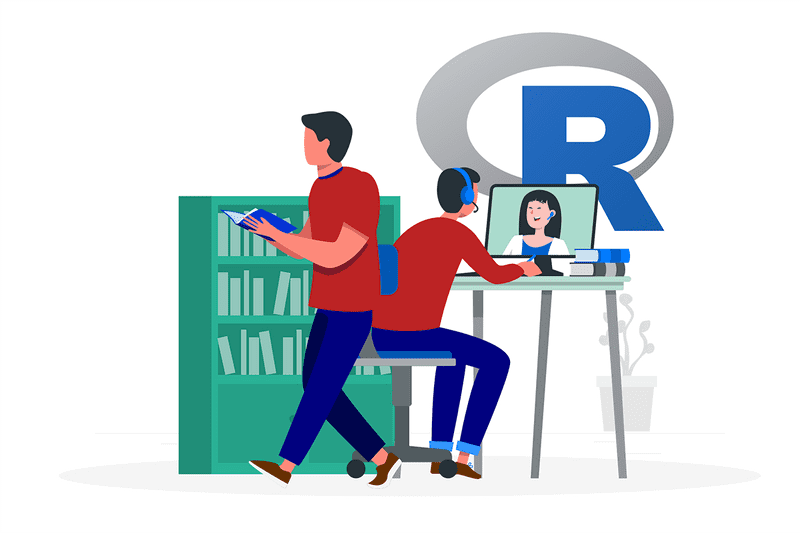From Microsoft XBox’s matchmaking service to the New York Times’ news cycle infographics and the National Weather Service’s flood forecasts, R programming is all around us.
Developed in the 1990s by Ross Ihaka and Robert Gentleman at the University of Auckland, R is a popular data science language for structured and unstructured data, supported by the R Foundation for Statistical Computing.
Relatively easy to learn compared with other programming languages, R is an excellent tool for data analysis, statistics, and data visualization. Here is how to learn it in 4 steps.
What is R?
R is a graphical and statistical language that encompasses linear regression, machine learning algorithms, statistical inferences, and time series.
A few unique features of R are that it gives you access to an open-source distributed computing platform and comes with over 5,000 packages that expand analytical capabilities, as well as many libraries, like ggplot2 and plotly, that help create visuals and graphics.
With R, you can import Excel, CSV, and other text files, process and transform the data to add new columns or replace missing data, explore trends through optimization, random number generation, signal processing, and other statistical techniques, and then produce scatterplots, line charts, bar graphs, histograms, density plots, and other charts, which you can export and add to presentations.
Why learn R?
There are several reasons why the R programming language is still appealing for data scientists, despite Python’s rise in popularity. For example:
- R has great data visualization tools, fast development time (since it can run code directly without a compiler), and the capacity to build powerful web apps.
- R has an active online support community through fora like KDNuggets and R-Bloggers. Unfortunately, given that R is open-source, there is no customer support helpline and you will often depend on crowdsourced answers to your questions. The code quality in some packages may also vary depending on the contributors. In addition to online advice, there are conferences, like useR! and WhyR?, events, and meetups.
- R is a free software environment to download and use, which makes it more suitable for individuals than expensive enterprise licenses like SAS.
Can you learn R on your own?
Contrary to common opinion, you don’t need an advanced degree or prior experience to master R syntax and become an entry-level data scientist. You can learn the language through R tutorial videos, blogs, online courses, and books, many of which are free to access. Springboard has a number of courses that cover R fundamentals.
Related Read: 45 R Interview Questions and Answers for Interview Prep
Is R a dying language?
Although Python has overtaken R as the most commonly used language by data scientists, R is still an important part of many data science toolkits, particularly in academic research. R is also used by many large companies around the world, including Google, Uber, Airbnb, and Facebook.
How is R used in data science?
From credit risk modeling in banking to performing pre-clinical trials in healthcare and analyzing social media sentiment for retail organizations, R has led to progress across many industries. R is used in data science for exploratory data analysis and descriptive statistics, painting a picture of data features, like mean, variability, degrees of dependence and correlation, central tendency, kurtosis, skewness, and discrete and continuous probability. It can also facilitate graphing, hypothesis testing, and predictive model generation.
Get To Know Other Data Science Students
Bryan Dickinson
Senior Marketing Analyst at REI
Aaron Pujanandez
Dir. Of Data Science And Analytics at Deep Labs
Lou Zhang
Data Scientist at MachineMetrics
Is R easier than Python?
R is different from Python and uses more unconventional syntax, but it shouldn’t be too challenging, especially for those with prior knowledge of another coding language.
In deciding which language to learn first, consider the projects you will be working on. R tends to a language more suited for mathematicians, statisticians, and those in industry or academia, whereas computer engineers at tech companies often prefer Python, given its applications for software and web development.
R for beginners: how to learn R in 4 steps
Here are some tips for becoming an R pro in no time:
- Download R on your computer. You can download a copy of R on Max, Windows or Linux by following these instructions from the Comprehensive R Archive Network (CRAN).
- Learn basic R principles. You will first need to become familiar with concepts like variables, strings numbers, vectors, matrices, data frames, factors, date and time objects, arrays, lists, control structures, and loop functions. Make sure that you choose a learning environment with practice problems and regular feedback.
- Download the right packages. R packages are reusable pieces of code that can expand your data import, wrangling, and visualization capacities. Whether you want to read and write Microsoft Excel files from R or integrate with a SAS or SPSS dataset, different packages will help you achieve your goals. This book provides an overview of how to use R packages.
- Apply your skills in real-world settings. Depending on your interests, there are many opportunities for you to take on real projects. For data science/data analysis, try Dataquest, R for Data Science, TidyTuesday. For data visualization, try ggplot2 (customizable graphics and plots), rgl (3D visualizations), ggvis (web graphics), htmlwidgets (javascript based visualizations), googeVis (Google Chart tool integration).
By adding these to Github or other online project portfolios, you can increase your competitiveness for job openings and show your new skills to recruiters. R you ready for a new adventure?
Since you’re here…
Curious about a career in data science? Experiment with our free data science learning path, or join our Data Science Bootcamp, where you’ll get your tuition back if you don’t land a job after graduating. We’re confident because our courses work – check out our student success stories to get inspired.





![14 Data Science Careers to Consider [Skills, Salary, Role]](https://www.springboard.com/blog/wp-content/uploads/2021/11/14-data-science-careers-to-consider-skills-salary-role.jpg)